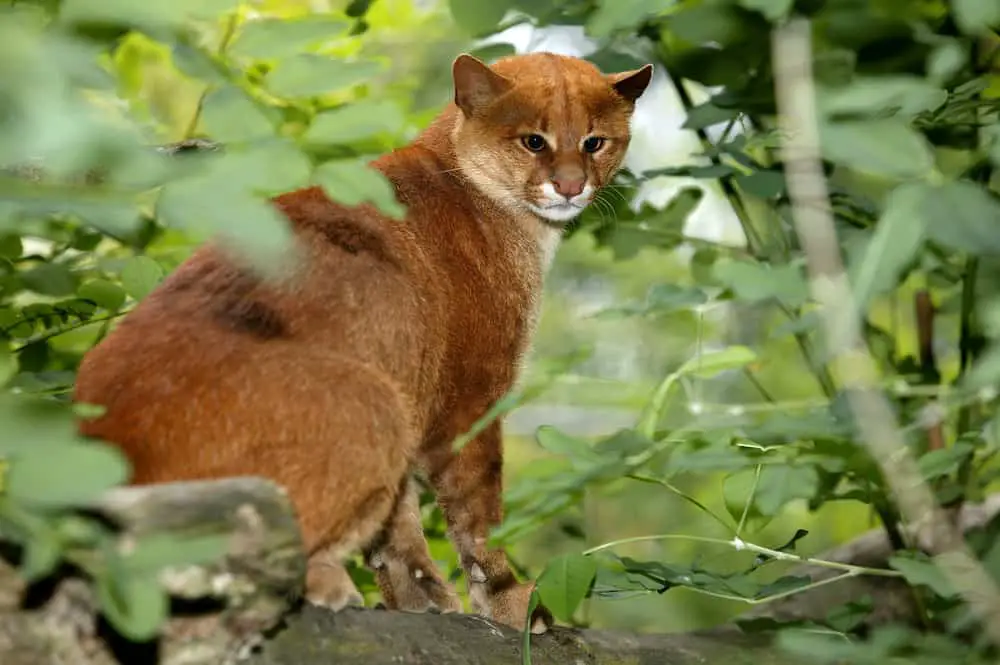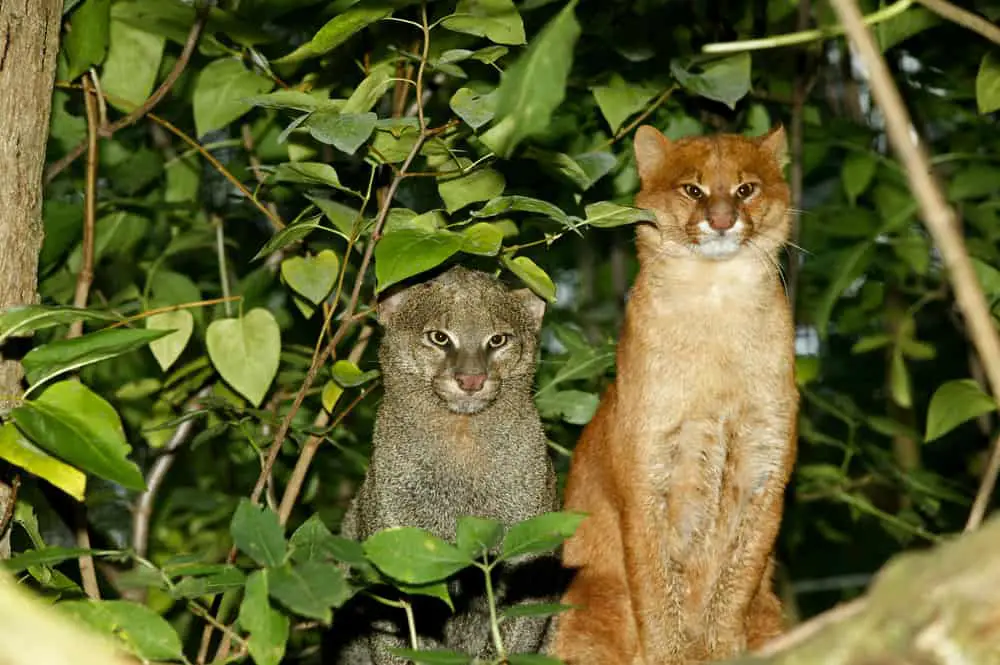The jaguarundi cat is a small wildcat that inhabits the dry forests and scrublands of Central and South America. It has an unusual appearance, with a long body and short legs as well as short, rounded ears. The coat of this species can vary in color from gray to reddish-brown depending on its location and subspecies.
Despite having been recorded since 1560 by Spanish settlers, much remains unknown about the behavior and ecology of this animal due to its elusive nature. This article will discuss the natural history of jaguarundi cats, their habitats, behaviors, and conservation status.
This medium-sized feline is a member of the family Felidae, ranging from 18–24 inches in length with a weight between 4–9 pounds. They are typically solitary animals who occupy large territories up to 3 miles long despite being relatively small for felines.
Unlike other members of this family, they hunt during both day and night; making them one of the few diurnal cats in existence today. Their diet consists primarily of rodents and birds but also includes reptiles such as snakes or lizards when available in their habitat.
Jaguarundis inhabit multiple countries throughout Central and South America including Mexico, Brazil, Peru, Ecuador and Argentina among others; with some reports indicating sightings into North America as far north as Texas.
In general however their populations have seen rapid declines over recent decades due to habitat destruction caused by human settlement expansion along with hunting pressure from local communities which often use them for bushmeat trade networks

Overview Of Species
The jaguarundi, a wildcat species of small-sized cat native to Central and South America, is found in parts of Mexico, Venezuela, Peru, Brazil as well as other areas. The genus Puma yagouaroundi is the scientific name for this medium-sized carnivore.
They are noted for their deep grey or black fur coat which is short not only on the body but also on the legs and tail. This gives them an overall uniform colouring that helps with camouflage when hunting prey in dense vegetation or near water sources.
Jaguarundis have a wide home range area – up to 4 square kilometres per individual – during its search for food such as rodents, frogs, lizards and even fish from freshwater streams. These cats can climb trees too if necessary to get closer to potential prey items like birds or monkeys in the canopy layer of tropical forests.
This species has been listed by IUCN (International Union for Conservation of Nature) as Least Concern due to its large population numbers although some localised populations may be threatened due to habitat destruction through urbanisation or agricultural activities. It is therefore important that suitable habitats remain intact so that these animals can continue living in their natural environment safely.
Physical Characteristics
The jaguarundi cat, or Puma yagouaroundi, is a small wildcat species known for its short-tailed, slender body and pointed ears. The size of an adult typically ranges from 18 to 24 inches in length with a weight of 8 to 16 pounds. They have brown-grey fur on their upper parts which fades into black towards the underside. Their heads are flattened and they have long whiskers and black-tipped tails.
Jaguarundis possess great agility that allows them to climb trees successfully as well as catch prey such as rodents, reptiles, birds and fish. This can be attributed to their strong hind legs, flexible spine and retractable claws that help them move quickly over difficult terrain. Furthermore, their eyesight and hearing also aid in capturing prey effectively or avoiding predators.
To ensure survival in any environment, the jaguarundi has developed several behavioral traits including scent marking using urine, making vocalizations like growls and purring when threatened or frightened and being active during dusk rather than peak hours of sunlight. In addition they tend to form loose social groups while living together during mating season but revert back to solitary lives after reproducing young ones.
Overall, the physical characteristics combined with behavior traits makes this species highly adaptable yet elusive creature in nature whose population numbers remain largely unknown due to difficulty detecting evidence of presence.
Habitat And Distribution
The jaguarundi, or Puma yagouaroundi, is a wild cat with an impressive range of habitat preferences. Found mostly in South and Central America, its natural distribution stretches from the southern United States to northern Argentina. However, due to human activities like land conversion and hunting, its numbers have significantly declined in some parts of this region.
The jaguarundi prefers habitats that are close to water sources such as streams and rivers, which provide them access to prey animals like rodents and rabbits. They also inhabit tropical rainforests, dry woodlands, shrubland savannas, evergreen forests and even semi-desert regions. Since they are excellent swimmers and climbers, they can be found between elevations ranging from sea level up to 5500 feet (1700 meters).
Jaguarundis usually live alone but may form pairs during mating season when young kittens are raised together for several months until old enough to hunt on their own. In areas where populations remain stable or increasing, these cats can reach densities of 1 per 10 hectares depending on available resources such as food supply and suitable cover for protection from predators.
Despite potential threats posed by humans including poaching for fur trade and destruction of their habitat through logging operations or urban development projects, jaguarundis continue to thrive in many parts of their historical range today.
Jaguars’ Predators Exposed: Unveiling the Natural Foes
Diet And Hunting Habits
Jaguarundi cats are carnivorous species, primarily consuming small prey items. Their dietary habits and hunting behavior exhibit an opportunistic approach to foraging in which they will hunt a wide variety of food sources depending on the season or availability.
Commonly eaten prey types include rodents, birds, reptiles, amphibians, insects and fish. An analysis of their feeding ecology reveals that they prefer smaller animals such as mice and lizards.
The jaguarundi cat is an ambush predator typically stalking its prey before pouncing from hiding places like dense vegetation or fallen logs. They employ a combination of stealthy movements until close enough to launch a successful attack.
Foraging patterns change throughout the year with larger prey items generally being consumed during the dry seasons when water is scarce and game is more concentrated around watering holes. Prey selection also varies according to location; frogs may be taken near lakes while rabbits and hares can be hunted in open plains habitat.
Given their size and agility, jaguarundis are well adapted for capturing unsuspecting prey by surprise attacks from cover or stalking them along edges of streams or paths through thickets where they lie waiting until close enough to strike with lightning speed and efficiency.
This strategy is effective at minimizing energy expenditure while maximizing diet diversity and providing adequate nutrition for maintaining health.
Reproduction And Lifespan
The jaguarundi is a solitary species, with females and males only coming together for brief periods of time to breed. Breeding season typically occurs from late spring until early fall in North America. During this period, the male will court the female by engaging in a wide variety of behaviors such as rubbing her face, purring loudly and scent-marking his territory.
After mating has taken place, she will seek out den sites where she will give birth between 65–75 days later. Litters range anywhere from two to four kittens who are born blind but well developed at birth.
Kittens remain in their den site until they reach 6 weeks old when they begin following their mother on hunting trips and other excursions away from home base. At around 12 months old, the young jaguarundis become independent and disperse into new territories of their own. The lifespan of these cats varies depending on their habitat; however, it can be up to 14 years in captivity or 10 years in the wild for healthy individuals.
Understanding more about jaguarundi reproduction and lifespan is essential for conservation efforts aimed at preserving them as well as understanding how an animal’s life cycle plays a role in its ability to survive within an environment.

Conservation Status
The jaguarundi cat is currently listed by the International Union for Conservation of Nature (IUCN) as “Near Threatened”. In other words, this species may become endangered if conservation efforts are not put in place.
In Mexico, jaguarundis have been identified as a priority species within their national biodiversity strategy and action plan. The current population size of the species is estimated to be between 4,000 – 6,000 individuals – with about half of them living in Mexico. To protect these animals from further decline, various conservation measures have been implemented:
- Habitat protection: Establishing protected areas or reserves that will maintain healthy habitats for jaguarundis and other wildlife has proven effective at conserving this species.
- Education programs: Raising awareness of the importance of preserving wildlife through educational campaigns can help reduce human-wildlife conflict and promote sustainable practices.
- Research studies: Conducting research on the ecology and behavior of jaguarundis helps us better understand how we can best manage populations and improve habitat management techniques.
However, despite these efforts there are still many threats to the survival of jaguarundis such as poaching, loss of habitat due to deforestation, urbanization and agricultural activities; all leading to an ongoing decrease in population numbers across their range. Therefore it is essential that more concerted effort is put into protecting this rare animal so future generations will also be able to enjoy its beauty.
Interaction With Humans
The interactions between humans and jaguarundis are complex, as the species is widely dispersed in their range. Historically, there have been very few reported cases of direct contact between jaguarundi and people. Even today, sightings of this wildcat remain sparse, with most encounters occurring during rare occasions when they come into contact with human settlements or agricultural land.
When it comes to behavior related to humans, research has found that jaguarundis will typically flee upon encountering a person due to their semi-solitary nature and shyness. However, recent studies suggest that the two species may be able to peacefully coexist if given enough space and resources to survive without coming into conflict with one another.
Conclusion
The jaguarundi cat is a remarkable species that has adapted to many different habitats throughout its range. It is an agile, powerful hunter with distinctive physical characteristics and a diet made up of rodents, small birds, lizards and other prey items. Its reproductive cycle consists of two litters per year with an average lifespan in the wild of 8-10 years.
Although considered rare in some areas where it inhabits due to habitat loss or hunting pressure, this species remains classified as Least Concern by the International Union for Conservation of Nature (IUCN).
Despite their shy nature and preference for avoiding human contact, jaguarundis may be kept as pets when obtained at a young age if they are provided proper care and nutrition. Such captive animals have been known to live longer than those found in the wild under optimal conditions. In addition, they can provide companionship similar to that of domestic cats while bringing unique traits from their wild heritage into homes across the world.
Overall, jaguarundis play an important role in ecosystems across Central America, South America and Mexico through their role as both predator and prey. Their adaptability makes them well suited to survive changes in land use but their conservation status should remain closely monitored so that these mysterious cats continue to thrive for generations to come.

